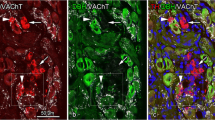Summary
The early development of the sympathetic chain with adjacent ganglia and chromaffin tissue and the appearance of monoamines in these organs was mapped with the Falck-Hillarp fluorescence technique. In the 11 days embryo a few fluorescent cells are found lateral to the aorta in the thoracal region. During the following days the sympathetic chain with segmentally arranged ganglia develops. The cells have a weak to medium fluorescence intensity. A migration of fluorrescent cells ventral to the sympathetic chain can be seen in embryos 12 days old. These migrating cells will later form the prevertebral ganglia and the chromaffin tissue. At the 14 days old stage the adrenal medulla and the paraganglia can be distinguished, while the prevertebral plexa are differentiated in the 15 days old embryo.
The chromaffin tissue has a brilliant fluorescence but in the neonatal stages parts of the paraganglia show a weaker fluorescence and though they have their largest extension around the 10th day of postnatal life a brilliant fluorescence can be seen only in a smaller part of the ganglia at that time. The paraganglia are reduced in adult stages.
Similar content being viewed by others
References
Allen, E.: The oestrus cycle in the mouse. Amer. J. Anat. 30, 297–371 (1922).
Björklund, A., Enemar, A., Falck, B.: Monoamines in the hypothalamo-hypophyseal system of the mouse with special reference to the ontogenetic aspects. Z. Zellforsch. 89, 590–607 (1968).
Brundin, T.: Studies on the preaortal paraganglia of newborn rabbits. Acta physiol. scand. 70, Suppl. 290, 5–54 (1966).
Coupland, R.: The development and fate of the abdominal chromaffin tissue in the rabbit. J. Anat. (Lond.) 90, 527–637 (1956).
Coupland, B.: The postnatal distribution of the abdominal chromaffin tissue in the guineapig, mouse and white rat. J. Anat. (Lond.) 94, 244–256 (1960).
—: The natural history of the chromaffin cell. London: Longmans, Green and Co. Ltd. 1965.
Dahlström, A.: Observations on adrenergic innervation of dog heart. Amer. J. Physiol. 209, 689–692 (1965).
DeChamplain, J., Malmfors, T., Olson, L., Sachs, Ch.: Ontogenesis of peripheral adrenergic neurons in the rat: pre- and postnatal observations. Acta physiol. scand. 80, 276–288 (1970).
Enemar, A., Falck, B., Håkanson, R.: Observations on the appearance of norepinephrine in the sympathetic nervous system of the chick embryo. Develop. Biol. 11, 268–283 (1965).
Eränkö, O., Härkönen, M.: Histochemical demonstration of fluorogenic amines in the cytoplasm of sympathetic ganglion cells of the rat. Acta physiol. scand. 58, 285–286 (1963).
——: Monoamine-containing small cells in the superior cervical ganglion of the rat and an organ composed of them. Acta physiol. scand. 63, 511–512 (1965).
Euler, U. S., Hillarp, N.-Å.: Evidence for the presence of noradrenaline in submicroscopic structures of adrenergic axons. Nature (Lond.) 177, 44–45 (1965).
Falck, B.: Observations on the possibilities of cellular localization of monoamines by a fluorescence method. Acta physiol. scand. 56, Suppl. 197, 1–25 (1963).
—, Hillarp, N.-Å., Thieme, G., Torp, A.: Fluorescence of catecholamines and related compounds condensed with formaldehyde. J. Histochem. Cytochem. 10, 348–354 (1962).
Owman, Ch.: A detailed methodological description of the fluorescence method for the cellular demonstration of biogenic monoamines. Acta Univ. Lund. 11 No 7 (1965).
Fernholm, M.: On the development of the sympathetic chain and the adrenal medulla in the mouse. Z. Anat. Entwickl.-Gesch. 133, 305–317 (1971).
Hamberger, B., Norberg, K.-A.: Monoamines in sympathetic ganglia studied with fluorescence microscopy. Experientia (Basel) 19, 580–581 (1963).
——, Ungerstedt, U.: Adrenergic synaptic terminals in autonomic ganglia. Acta physiol. scand. 64, 285–286 (1965).
Hammond, W., Yntema, C.: Depletions on the thoraco-lumbar sympathetic system following removal of neural crest in the chick. J. comp. Neurol. 86, 237–265 (1947).
Hollands, B., Vanov, S.: Localization of catecholamines in visceral organs and ganglia of the rat, guinea-pig and rabbit. Brit. J. Pharmacol. 25, 307–316 (1965).
Jacobowitz, D.: Histochemical studies of the autonomic innervation of the gut. J. Pharmacol. exp. Ther. 149, 358–364 (1965).
Norberg, K.-A., Ritzeń, M., Ungerstedt, U.: Histochemical studies on a special catecholaminecontaining cell type in sympathetic ganglia. Acta physiol. scand. 67, 260–271 (1966).
Olson, L.: Outgrowth of sympathetic adrenergic neurons in mice treated with a nerve-growth factor (NFG). Z. Zellforsch. 81, 155–173 (1967).
Polak, J., Rost, F., Pearse, A.: Fluorigenic amine tracing of neural crest derivatives forming the adrenal medulla. Gen. comp. Endocr. 16, 132–136 (1971).
Read, J., Burnstock, G.: Development of the adrenergic innervation and chromaffin cells in the human fetal gut. Develop. Biol. 22, 513–534 (1970).
Rugh, R.: The mouse: Its reproduction and development. Minneapolis: Burgess 1968.
Shepherd, D., West, G.: Noradrenaline and accessory chromaffin tissue. Nature (Lond.) 170, 42–43 (1952).
Vogt, M.: The concentration of sympathin in different parts of the central nervous system under normal condition and after administration of drugs. J. Physiol. (Lond.) 123, 451–481 (1954).
Weston, J.: A radioautographic analysis of the migration and localization of trunk neural crest cells in the chick. Develop. Biol. 6, 279–310 (1963).
Author information
Authors and Affiliations
Rights and permissions
About this article
Cite this article
Fernholm, M. On the appearance of monoamines in the sympathetic systems and the chromaffin tissue in the mouse embryo. Z. Anat. Entwickl. Gesch. 135, 350–361 (1972). https://doi.org/10.1007/BF00519044
Received:
Issue Date:
DOI: https://doi.org/10.1007/BF00519044



